Everything You Need To Know About Hoop Chicken Tractors
Is there a coop you could use to raise chickens more efficiently?
If you are a chicken farmer, this is a question you should ask yourself regularly. After all, a chicken coop that saves you time, money, and labor would be an incredibly wise investment.
Because ultimately, nothing affects your bottom-line profit more directly than how efficiently you raise your chickens.
But there’s a good chance you’ve asked yourself this question frequently and feel disillusioned with all the available chicken coops – each claiming to be the silver bullet to make your farm more profitable and efficient.
That’s why today, we want to cut through the fluff and talk about hoop chicken tractors. We’re putting our years of experience at The Mobile Chicken House to good use to help you decide if a hoop coop is what you need to take your chicken farm to the next level. As a bonus, we’ll discuss features every chicken coop should have, no matter which style you choose.
Ready to get the answers you’ve been looking for? Let’s get started!
1. What is a Hoop Coop?
Let’s begin by ensuring we’re on the same page. What exactly is a hoop coop?
A chicken hoop coop looks like an arch-shaped greenhouse used to grow plants. This makes sense because arch-shaped greenhouses sometimes go by another name: hoop houses.
Because this chicken coop style looks like a greenhouse (or a hoop house), they are called hoop coops.
Hoop coop pens are made from lightweight metal bent into a semicircle, attached to a bottom frame, and covered with a heavy-duty tarp or plastic. The ends of the coop are framed with wood or metal and have a sizable door in the front for easy access to the enclosure.
The bottom frame of a hoop coop is constructed as a skid, making the houses a breeze to move.
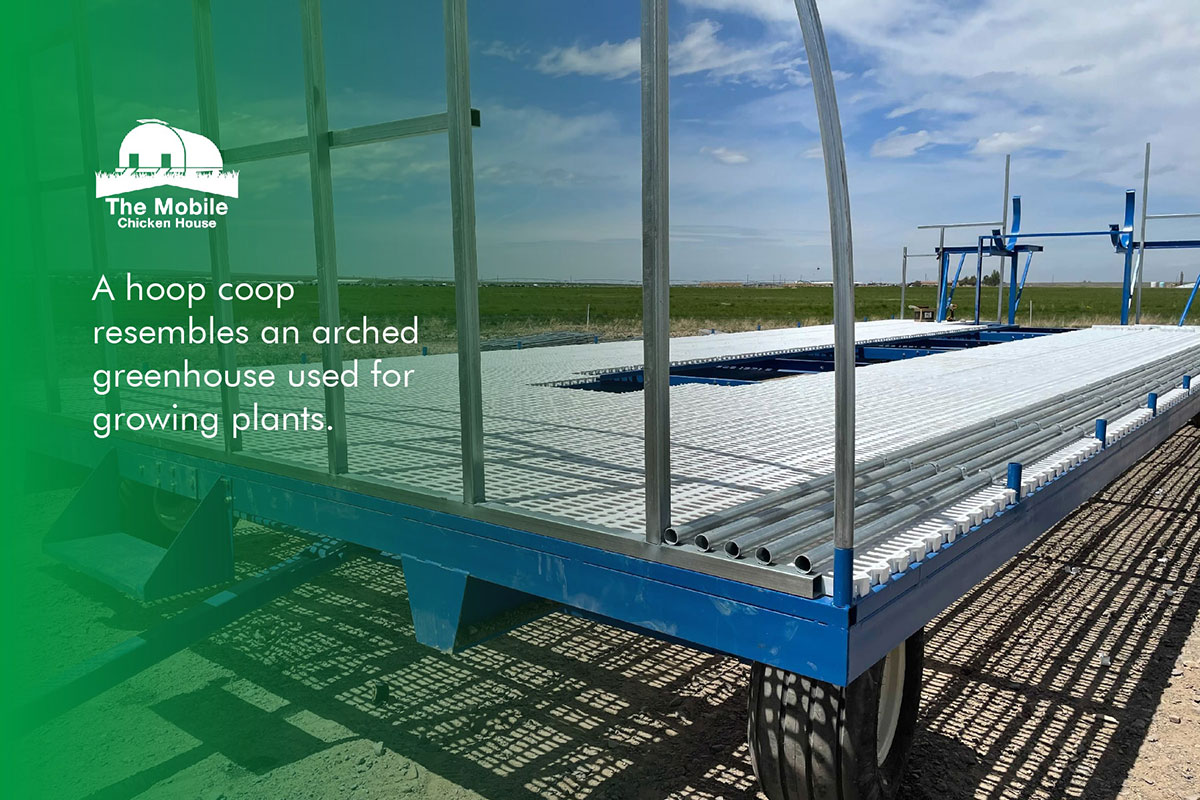
2. What is a Chicken Tractor?
The idea of a chicken tractor first arose from the concept of regenerative agriculture.
Regenerative agriculture is the idea of farming and ranching in harmony with nature. There is no strict rule book, but the holistic principles behind the system are meant to restore soil and ecosystem health and leave our land, waters, and climate in better shape for future generations.
Proponents of this system realized that raising chickens on pasture could be helpful in this pursuit.
When chickens are in an enclosed coop all day, they do nothing to improve the soil and environment. But when they are put to pasture, they can make the soil healthier and even improve our lives.
For example:
- Chicken manure fertilizes the soil, rather than being a nuisance
- Pecking and scratching aerates and rejuvenates the soil
- Pasture-raised chicken meat and eggs are healthier than non-pasture raised.
Obviously raising chickens on pasture sounds like a good idea. But you can't have chickens roaming free all over your farm! That’s where chicken tractors come in.
A chicken tractor is a floor-less mobile shelter used to raise poultry on managed pasture. The daily movement of the shelter allows for proper management of soil health, which in turn affects every part of the farm.
They are called chicken “tractors” because the chickens' scratching loosens an inch or so of earth, mimicking what a tractor would do on a small scale.
Now, let’s combine the definition of a hoop coop with a chicken tractor.
What we get is a hoop chicken tractor – an arch-shaped, floor-less, mobile chicken coop that is easy to move and use when a farmer wants to utilize regenerative agriculture practices.
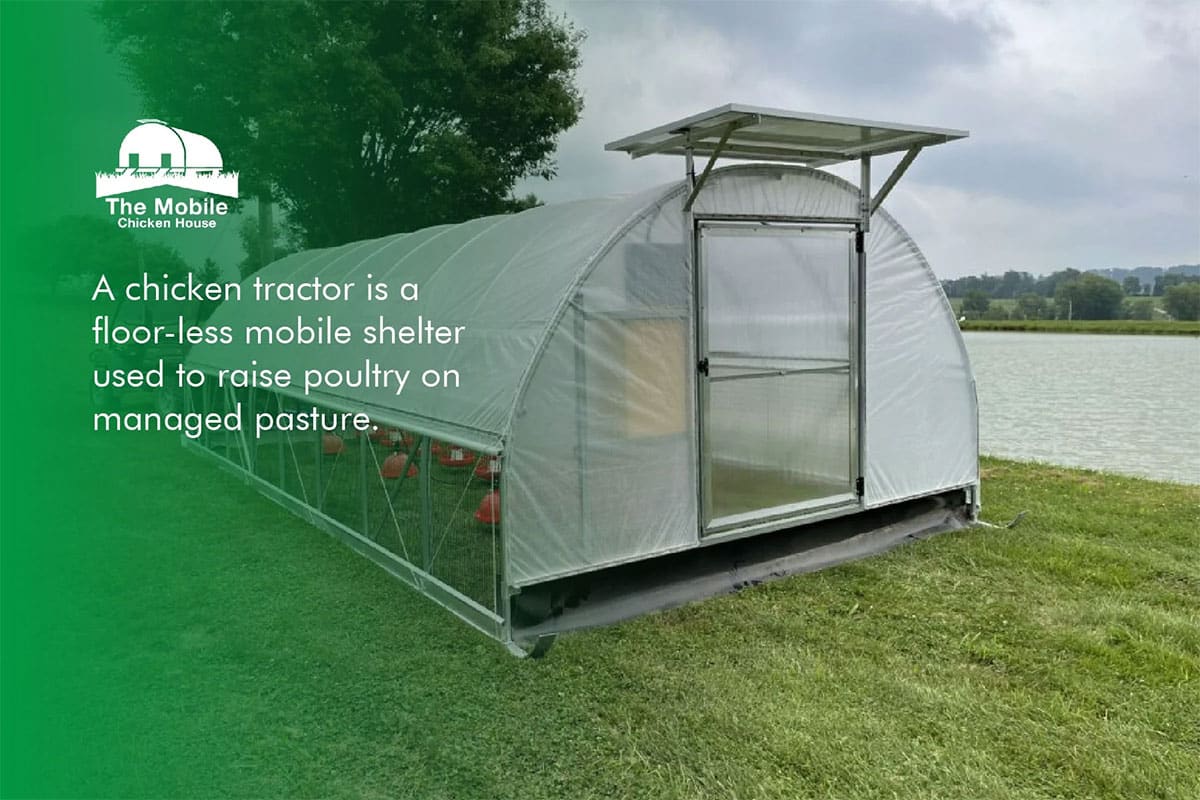
3. Pros and Cons of a Hoop Chicken Tractor
Now that we know the story behind the creation of hoop chicken tractors let’s take a look at how good the idea really is.
We’ll explore the pros and cons of a hoop chicken tractor so you can make an informed decision about whether or not it is a good chicken coop style for you.
Pros of a Hoop Chicken Tractor
1 - Affordable to build and buy
Other styles of chicken coops are usually more expensive than hoop coops. That’s because arched chicken coops require less internal structure to remain sturdy. Instead of welded or bolted trusses, the structure is made up of curved bows and simple purlins.
Want to learn more about saving money and staying profitable with your poultry business? Check out 2 of our blogs:
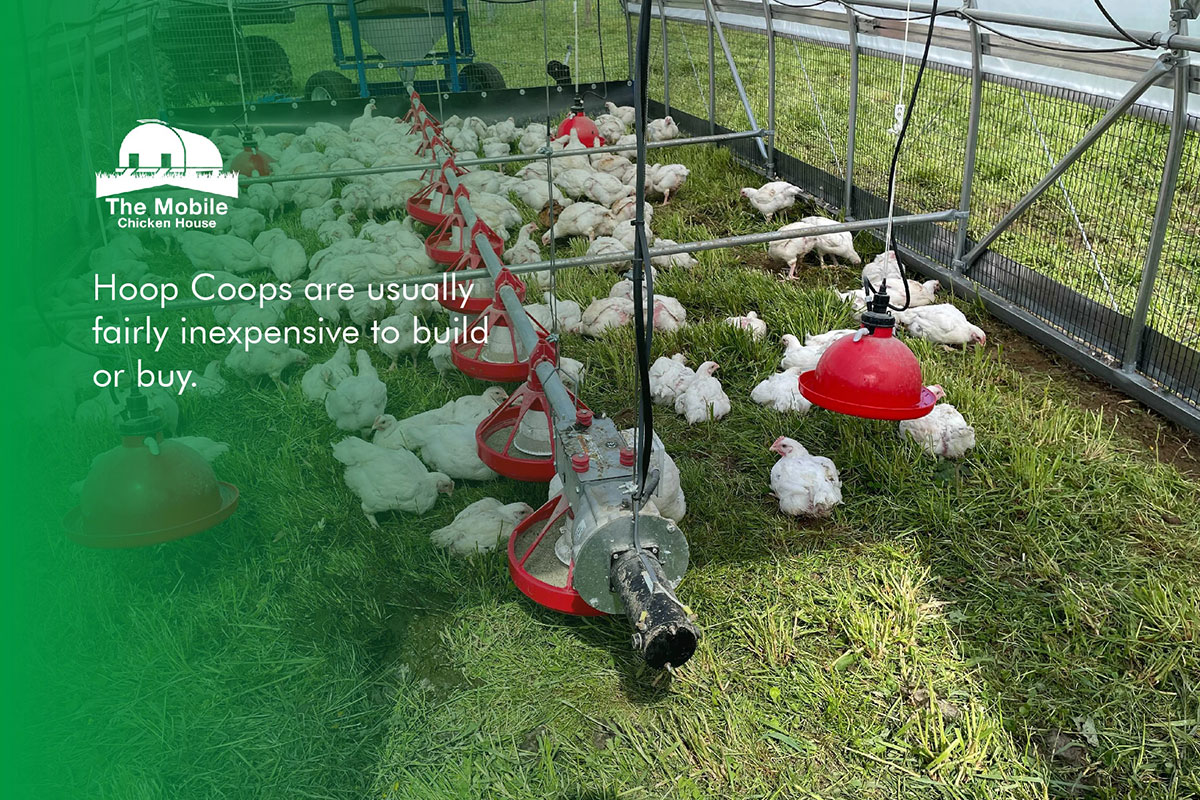
2 - Plenty of room to access the coop
Conventional wisdom among farmers and ranchers says that you should either be able to access your entire chicken coop from the outside or enter the pen without too much trouble.
The logic is simple: You don’t want to crawl around on your hands and knees chasing down a chicken.
Unfortunately, many chicken tractors are built as low, box-like structures. While these work fine in most instances, they are a serious headache when you need to access something like a sick chicken at the back of the coop.
3 - Efficient space use
Some styles of chicken houses, like an A-frame coop, give you excellent access to the pen’s interior but aren’t the best use of space.
Think about it:
Chickens can’t roostwhere the roof comes together at the point. On the other hand, with a round top, this area can be equipped with roosting bars.
4 - Easy to ventilate
Chickens generate a lot of moisture, ammonia, and heat – so it’s critical to ventilate well to remove the excess from the coop.
If you don’t ventilate well, you’ll see symptoms in your flock that range from irritated eyes and sinuses to respiratory distress, overall poor health, or even death in extreme cases.
As you can imagine, traditional chicken houses can be a bit tricky to ventilate. Usually, they require an opening and exhaust fan to operate.
However, hoop chicken tractors are covered with a tarp or plastic, so it’s not difficult to roll the covering up a few feet close to the ground and provide your chickens with a well-ventilated space!
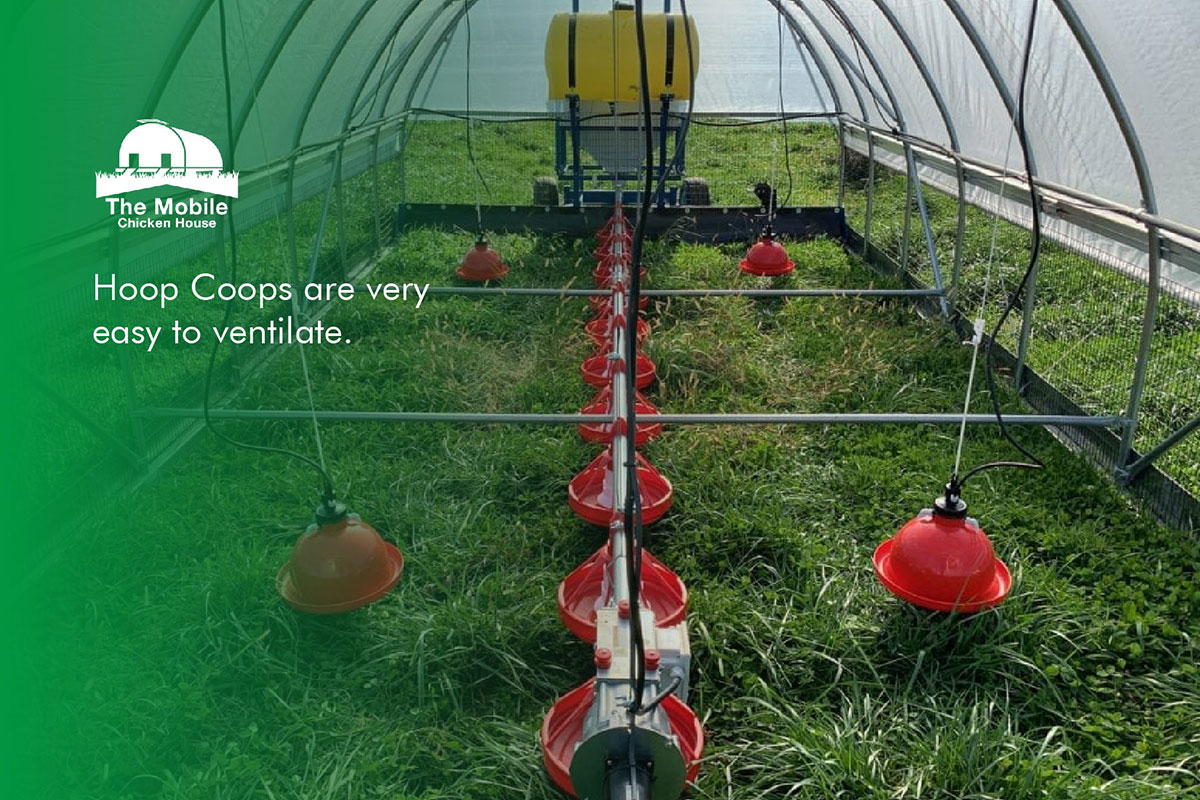
5 - Easier to move
Hoop chicken tractors were built with pastured poultry in mind, so making them easier to move is a primary goal. At The Mobile Chicken House, most of our coops can be moved with a heavy-duty RTV or small tractor instead of always needing a large tractor close by.
Cons of a Chicken Hoop Tractor
Nothing is completely perfect, and while hoop coops have many positive attributes, there are a few drawbacks to consider before purchasing.
Let’s look at a few negative aspects of chicken hoop tractors.
1 - Not as sturdy as other models
Hoop tractors are completely adequate if you just want a place of protection for your chickens.
However, if you want to include things like hanging feeders, or an automatic water line in your coop, you may find the lighter structure doesn’t do the best at supporting these things.
The best solution is to add a ridge pole to the coop and hang your feeders from there.
2 - Tougher to keep warm in cold climates
Chickens can handle the cold pretty well – after all, they are basically poofy, down coats. In fact, chickens are perfectly comfortable at 40-45 degrees Fahrenheit and do well to a few degrees below freezing.
However, if you live in a climate where temperatures can plummet into the teens and below zero, you’ll have to make sure your chickens stay warm.
Unfortunately, a hoop coop's lighter, plastic construction means it doesn't stay as cozy and snug during the winter.
If you would like to use a hoop coop and live in a northern climate, here are a few tips for keeping your coop warm:
- If your enclosure is small enough, cover it with a few blankets to retain more heat
- Make sure the ground is always dry with biodegradable bedding like straw
- Stack a few hay bales around the outside or inside edge of the coop
- If possible, pull your pen inside a larger outbuilding
As you can see, this type of coop has both positives and negatives. At the end of the day, it is your decision on whether or not a hoop chicken tractor is for you.
Generally, though, these hoops are a great option for farmers and ranchers, and it only takes a little ingenuity and work to overcome some of the minor cons of hoop coops.

4. Four Features Every Hoop Chicken Tractor Should Have
Perhaps you’ve decided that you want to use a hoop coop in your backyard or on your farm. What features should you look for in a hoop coop?
1 - Easy Access Door
Putting a small door on a mobile chicken house would be like installing a garage door just big enough for your vehicle. You may be able to pull your car into the garage, but even a task as small as getting out of the vehicle suddenly becomes challenging!
Wide doors are essential in broiler houses when you will be carrying large crates in and out of the chicken coop.
Here at The Mobile Chicken House, we equip or hoop style range coops with a four-foot door for easy access.
2 - Automated Feed Lines
Treating any animal in an inhumane manner is a serious problem.
However, trying to grow meat chickens efficiently is perfectly ok - especially if you stay focused on quality-driven and sustainable growing methods.
That’s why we utilize automated feed lines in our broiler coops.
And it couldn’t be simpler:
- Load chicken feed in the 750-pound feed hopper
- Allow the power motor to deposit feed into individual feed trays automatically
- Watch the birds eat and grow!
We understand that you may want to build or buy a chicken house for as cheap as possible, but if you are raising chickens on a medium to large scale, the time and labor automatic feed lines save you will quickly pay off the price tag.
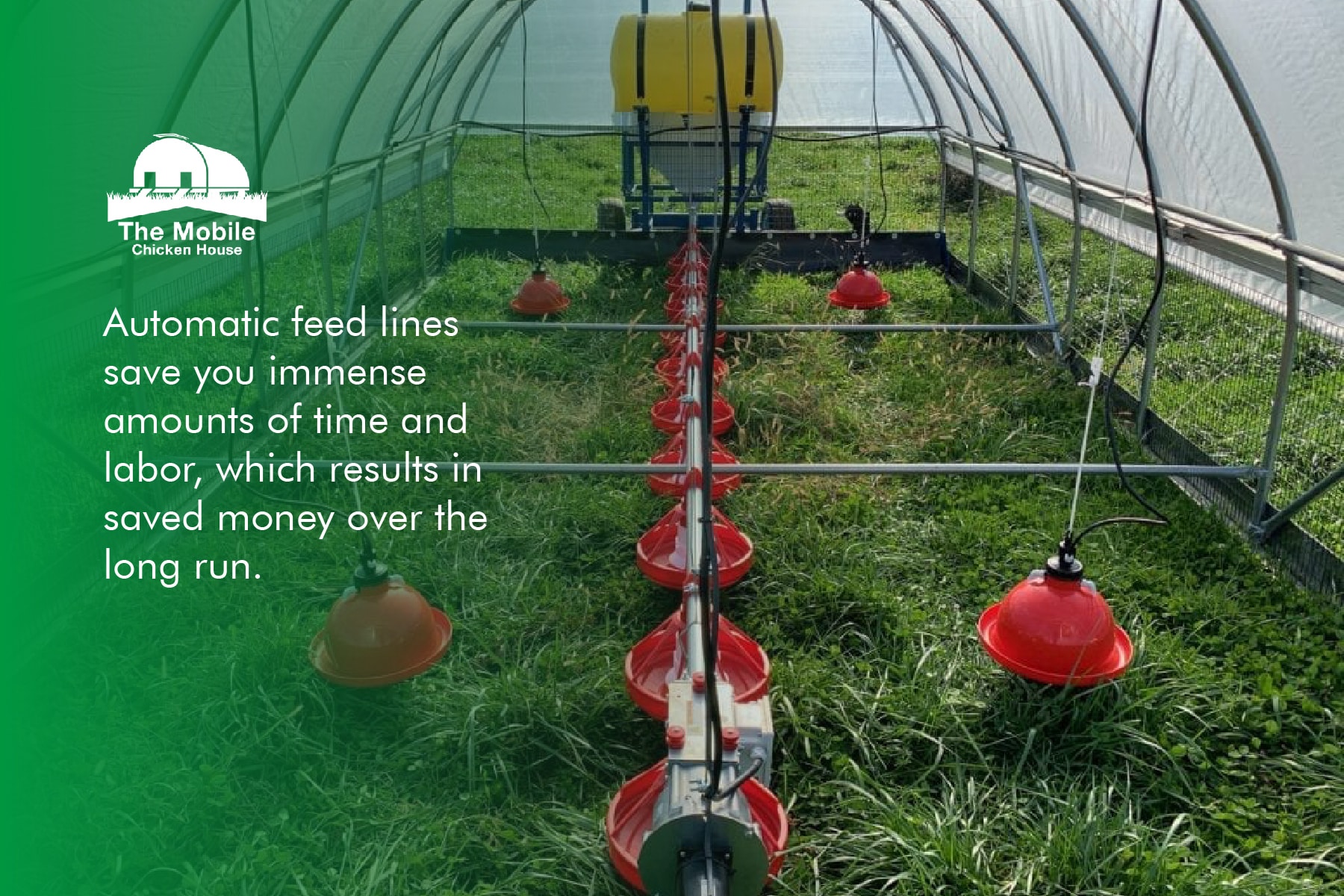
3 - Adjustable feeders
Many farmers know the frustration of having their chickens waste a lot of feed. In fact, a quick Google search on “chickens wasting feed” brings up about 746,000 search results!
If you make sure that your feeder’s height is even with the height of an average bird’s back, you can solve your problem. The chickens aren’t able to be picky and eat what’s given to them.
That’s why all the feeders in our mobile range coops can be adjusted simultaneously with the crank of a handle.
4 - A Rubber Flap to Protect Chickens
When moving your hoop coop, chickens sometimes forget to move with you! The coop can catch up to a chicken and run over it, injuring or killing it.
However, a rubber flap at the back of your coop allows the pen to ride over the bird and not harm them, which is much preferred to an injured or dead chicken!
Conclusion
By now, you should be armed with the information you need to know if a chicken hoop tractor is a good option for you.
As a bonus, you have a few features to keep your eye out for if you go the route of a chicken hoop tractor.
If you are interested in raising broilers or egg layers in a mobile chicken house, let The Mobile Chicken House team know. We would love to help you get started!
We offer mobile coops for broilers and multiple models of mobile chicken houses for egg layers.
We also offer chicken house financing, and if you want to explore the soundness of your investment, check out our profit calculator.
Contact us today. We look forward to hearing from you!
